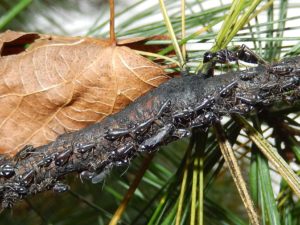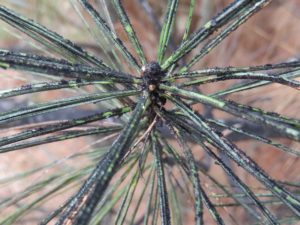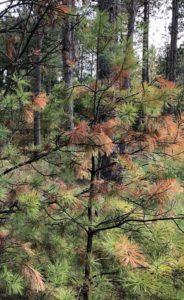Linda Williams, forest health specialist, Woodruff, Linda.Williams@wisconsin.gov, 920-360-0665
Ants, aphids, and sooty mold can cause stunting and death of young white pines, but fortunately there are some steps you can take to protect your trees from these pests.

Ants (upper right) guard aphids from predators as they feed. In exchange, the ants collect the sweet honeydew excreted by the aphids.
Young white pine trees with branches and twigs that are turning black may be infested with aphids. Aphids can often be found feeding on the branches and twigs of these trees, where they consume the sugary carbohydrates flowing through the tree. Excess sugars are excreted in a liquid known as honeydew, coating branches and needles with a thin sticky coating. Ants are often found in association with these aphids, providing protection in exchange for the honeydew. Excess honeydew coats the branches and needles of the tree, providing an ideal substrate for black sooty mold to grow.

Thick black sooty mold covers these white pine needles, reducing their photosynthetic ability.
This layer of black mold reduces the trees’ ability to photosynthesize and produce nutrients for itself, leading to stunted tree growth and fewer, shorter needles. Ant activity can also cause stunted tree growth by killing roots that interfere with their nests. Ants bite the interfering roots and inject formic acid which leads to root death. If enough roots die, needles, twigs and even the whole tree can be stunted or killed.

Young white pine stunted with branch mortality due to the presence of ants, aphids and sooty mold. Impacts likely occurred over a 1-2 year period with symptoms first observed in May 2019.
So, what can be done? To reduce the damages from aphids, ants and sooty mold, you must control either the ants or the aphids. Generally, the ants involved with white pine aphids are the Allegheny mound ants which, as their name suggests, build large mounds to house their colonies. All mounds start out flat, however, so look around your trees closely for any areas where lots of ants are present.
Ant control can be difficult and requires targeting either the nest itself or the ants’ food source. Direct control of the mounds includes using insecticides which are available in both powder and liquid forms. Powders can be used but will need to be repeated. Liquids can be applied by shoveling out a depression in the top of the mound or pushing a rod into the nest several times to create channels before pouring in the liquid insecticide. Nests can go several feet deep into the soil so getting the insecticide to penetrate the whole nest is important. Disturbing the nests can cause the ants to get quite testy and pour out of the nest in defense. You may want to wear rubber boots smeared with Vaseline or some other product to keep them from running up your pants legs and biting you … a very unpleasant experience.
If you’d rather try to target the food source, you can look into spraying your trees to eliminate the aphids. If there is no food for the ants, they may move on.
For more information, check out the UW-Extension factsheet or this Michigan State University page which both feature control recommendations.
